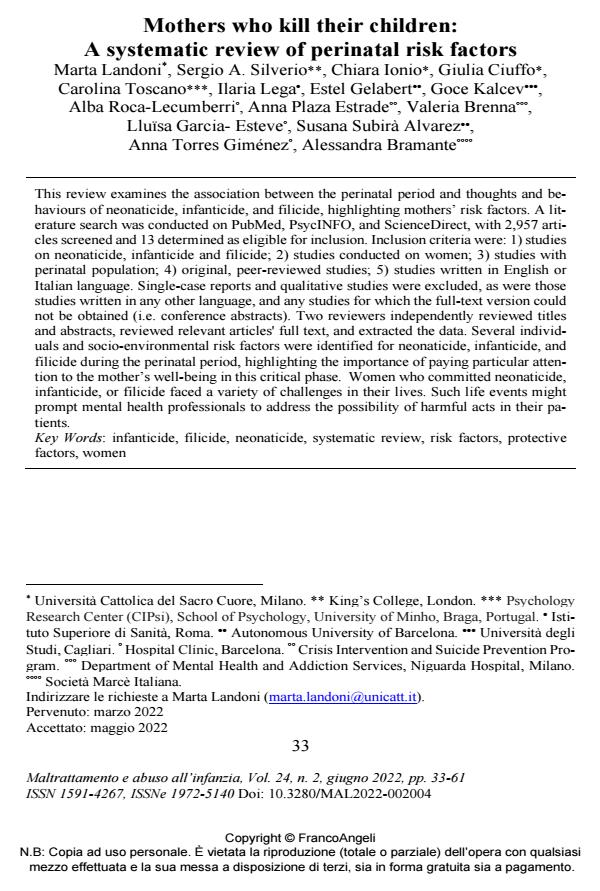Mothers who kill their children: A systematic review of perinatal risk factors
Titolo Rivista MALTRATTAMENTO E ABUSO ALL’INFANZIA
Autori/Curatori Marta Landoni, Sergio A. Silverio, Chiara Ionio, Giulia Ciuffo, Carolina Toscano, Ilaria Lega, Estel Gelabert, Goce Kalcev, Alba Roca-Lecumberri, Anna Plaza Estrade, Valeria Brenna, Lluïsa Garcia- Esteve, Susana Subirà Alvarez, Anna Torres Giménez, Alessandra Bramante
Anno di pubblicazione 2022 Fascicolo 2022/2
Lingua Inglese Numero pagine 29 P. 33-61 Dimensione file 315 KB
DOI 10.3280/MAL2022-002004
Il DOI è il codice a barre della proprietà intellettuale: per saperne di più
clicca qui
Qui sotto puoi vedere in anteprima la prima pagina di questo articolo.
Se questo articolo ti interessa, lo puoi acquistare (e scaricare in formato pdf) seguendo le facili indicazioni per acquistare il download credit. Acquista Download Credits per scaricare questo Articolo in formato PDF

FrancoAngeli è membro della Publishers International Linking Association, Inc (PILA)associazione indipendente e non profit per facilitare (attraverso i servizi tecnologici implementati da CrossRef.org) l’accesso degli studiosi ai contenuti digitali nelle pubblicazioni professionali e scientifiche
This review examines the association between the perinatal period and thoughts and behaviours of neonaticide, infanticide, and filicide, highlighting mothers’ risk factors. A literature search was conducted on PubMed, PsycINFO, and ScienceDirect, with 2,957 articles screened and 13 determined as eligible for inclusion. Inclusion criteria were: 1) studies on neonaticide, infanticide and filicide; 2) studies conducted on women; 3) studies with perinatal population; 4) original, peer-reviewed studies; 5) studies written in English or Italian language. Single-case reports and qualitative studies were excluded, as were those studies written in any other language, and any studies for which the full-text version could not be obtained (i.e. conference abstracts). Two reviewers independently reviewed titles and abstracts, reviewed relevant articles' full text, and extracted the data. Several individuals and socio-environmental risk factors were identified for neonaticide, infanticide, and filicide during the perinatal period, highlighting the importance of paying particular attention to the mother’s well-being in this critical phase. Women who committed neonaticide, infanticide, or filicide faced a variety of challenges in their lives. Such life events might prompt mental health professionals to address the possibility of harmful acts in their patients.
Questa rassegna esamina l’associazione tra il periodo perinatale e i pensieri e i comporta-menti di neonaticidio, infanticidio e figlicidio, cercando di mettere in luce i fattori di rischio materni. È stata condotta una ricerca della letteratura su PubMed, PsycINFO e ScienceDi-rect: sono stati esaminati 2.957 articoli di cui solo 13 ritenuti idonei all'inclusione. I criteri di inclusione erano: 1) studi su neonaticidio, infanticidio e figlicidio; 2) studi condotti su don-ne; 3) studi con popolazione perinatale; 4) studi originali, peer-reviewed; 5) studi scritti in lingua inglese o italiana. Sono stati esclusi i report di casi singoli e gli studi qualitativi, così come gli studi scritti in qualsiasi altra lingua, e tutti gli studi di cui non è stato possibile ot-tenere la versione full-text (es. abstracts di conferenze). Due revisori indipendenti hanno esaminato i titoli e gli abstract, hanno rivisto il testo completo degli articoli rilevanti e hanno estratto i dati. Sono stati identificati diversi fattori di rischio individuali e socio-ambientali per il neonaticidio, l’infanticidio e il figlicidio durante il periodo perinatale, evidenziando l'importanza di prestare particolare attenzione al benessere della madre in questa fase critica. Le donne che hanno commesso neonaticidio, infanticidio o figlicidio hanno affrontato una varietà di sfide nella loro vita. Tali eventi di vita potrebbero spingere i professionisti della salute mentale ad affrontare la possibilità di atti dannosi nei loro pazienti.
Parole chiave:infanticidio, figlicidio, neonaticidio, revisione sistematica, fattori di rischio, fattori protettivi, donne
- Current policy and practice for the identification, management, and treatment of postpartum anxiety in the United Kingdom: a focus group study Elizabeth J. Harris, Semra Worrall, Victoria Fallon, Sergio A. Silverio, in BMC Psychiatry 680/2024
DOI: 10.1186/s12888-024-06058-7 - Understanding Filicide Risk: A Scoping Review to Inform Mental Health Nursing Practice Claire Hayes, Alison Hansen, Louise Alexander, in International Journal of Mental Health Nursing e70155/2025
DOI: 10.1111/inm.70155 - A systematic review of clinical psychological guidance for perinatal mental health Jayne O’Brien, Lynsey Gregg, Anja Wittkowski, in BMC Psychiatry 790/2023
DOI: 10.1186/s12888-023-05173-1
Marta Landoni, Sergio A. Silverio, Chiara Ionio, Giulia Ciuffo, Carolina Toscano, Ilaria Lega, Estel Gelabert, Goce Kalcev, Alba Roca-Lecumberri, Anna Plaza Estrade, Valeria Brenna, Lluïsa Garcia- Esteve, Susana Subirà Alvarez, Anna Torres Giménez, Alessandra Bramante, Mothers who kill their children: A systematic review of perinatal risk factors in "MALTRATTAMENTO E ABUSO ALL’INFANZIA" 2/2022, pp 33-61, DOI: 10.3280/MAL2022-002004